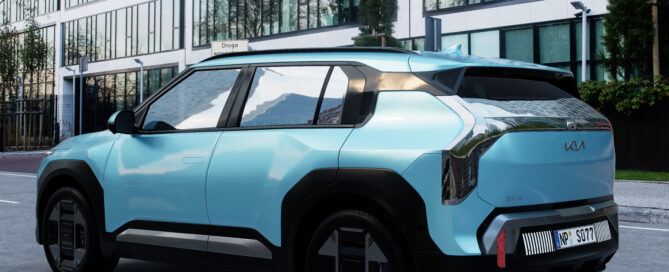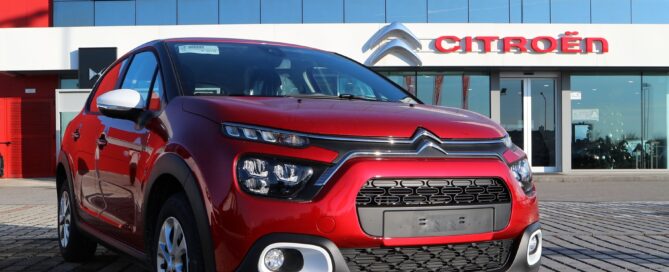Why Lease the New Kia EV3?
The Kia EV3 represents a significant leap forward in electric vehicle (EV) technology, offering a sustainable and high-performance driving experience. Leasing this cutting-edge vehicle could be the perfect option for those who want to enjoy all the benefits of an EV without the long-term commitment of purchasing one. Here’s why leasing the Kia EV3 might be the best decision you can make if you’re looking to drive a state-of-the-art, eco-friendly car.
Sustainable and Stylish: The Best of Both Worlds
Leasing the Kia EV3 gives you the opportunity to drive a vehicle that perfectly balances sustainability with style. The EV3 is a stunning example of Kia’s “Opposites United” design philosophy, which combines bold exterior aesthetics with an innovative, spacious interior. Its sleek, modern lines and strong stance not only make the EV3 visually appealing but also enhance its aerodynamic efficiency, which is crucial for maximizing range and performance.
Inside, the EV3 offers an environment that is as comfortable as it is sustainable. The cabin is thoughtfully designed with eco-conscious materials, including recycled and bio-based elements, ensuring that every drive contributes to reducing your carbon footprint. Leasing the EV3 allows you to experience this next-level sustainability without the upfront costs associated with purchasing a new vehicle.
Advanced Technology at Your Fingertips
One of the most compelling reasons to lease the Kia EV3 is its suite of advanced technologies. When you lease, you’re not just driving a car; you’re experiencing the future of automotive technology today. The EV3 comes equipped with Kia’s AI Assistant, a generative AI feature that makes your driving experience seamless and intuitive. Whether it’s adjusting the cabin temperature, finding the nearest charging station, or recommending a coffee shop on your route, the AI Assistant is there to make your journey as smooth as possible.
Additionally, the EV3’s high-tech infotainment system, featuring a panoramic wide display, is a marvel of modern design. This system integrates a 12.3-inch cluster, a 5-inch climate control panel, and a 12.3-inch infotainment screen, providing you with all the information and entertainment you need at a glance. Paired with the Harman Kardon sound system, the EV3 offers an immersive in-car experience that can be tailored to your preferences, with options to customise the display themes to match your mood or interests.
Leasing the EV3 means you can enjoy all these technological advancements without worrying about the long-term maintenance and upgrades that come with car ownership. As technology evolves, leasing allows you to stay ahead of the curve by upgrading to the latest models at the end of your lease term.
Impressive Range and Performance
Performance is a key consideration when choosing an electric vehicle, and the Kia EV3 doesn’t disappoint. The EV3 is powered by an 81.4 kWh battery, delivering a maximum range of up to 501 km on a single charge, according to Korean Ministry of Environment certification, with a WLTP range of up to 600 km under ideal conditions. This impressive range makes the EV3 a reliable choice for both city driving and long-distance travel.
In addition to its range, the EV3 supports fast charging, capable of charging from 10% to 80% in just 31 minutes. This feature is particularly beneficial for those who want the convenience of quick charging during road trips or busy days. Leasing the EV3 means you get to enjoy this convenience without the anxiety of battery degradation over time, as you can easily upgrade to a newer model when your lease term ends.
The EV3 also features Kia’s i-Pedal 3.0 system, which allows for one-pedal driving with adjustable regenerative braking. This system not only enhances energy efficiency but also reduces driver fatigue during extended drives, making it a great option for both daily commutes and longer journeys.
Flexibility and Innovation with Leasing
Leasing the Kia EV3 offers unmatched flexibility, particularly when it comes to staying current with automotive innovations. The EV3 is designed to evolve with your needs, thanks to over-the-air (OTA) updates that ensure your vehicle remains up-to-date with the latest software improvements. This means you can enjoy new features and enhancements throughout your lease term without the need for a trip to the service centre.
Moreover, the Kia EV3 is equipped with Vehicle-to-Load (V2L) technology, allowing the car to function as a portable energy source. This feature is especially useful for powering devices or even other electric vehicles, making the EV3 a versatile choice for those who need a reliable and flexible energy solution on the go. Leasing this vehicle means you can take advantage of these innovative features without the long-term commitment, allowing you to explore the latest advancements in EV technology as they become available.
Safety and Peace of Mind
When you lease the Kia EV3, you’re not just getting a high-performance vehicle; you’re also investing in safety. Kia has equipped the EV3 with an array of Advanced Driver Assistance Systems (ADAS) designed to protect both the driver and passengers. These systems include lane-keeping assistance, adaptive cruise control, and automatic emergency braking, among others. The combination of these safety features with the vehicle’s solid build quality and advanced materials ensures a safe driving experience, even in challenging conditions.
Leasing the EV3 also provides peace of mind when it comes to maintenance and repairs. With a lease, you’re typically covered by a manufacturer’s warranty for the duration of the term, meaning that many of the costs associated with maintenance and repairs are taken care of. This can be particularly advantageous for drivers who want to avoid unexpected expenses and enjoy a hassle-free ownership experience.
The EV3 GT-Line: For Those Who Want More
For drivers who want a bit more flair and performance, leasing the Kia EV3 GT-Line might be the perfect option. This variant includes all the features of the standard EV3 but with additional sporty design elements and performance upgrades. The GT-Line offers a more dynamic driving experience while maintaining the EV3’s commitment to sustainability and eco-friendly driving.
Leasing the GT-Line allows you to enjoy these enhanced features without the higher upfront costs associated with purchasing a premium model. And at the end of your lease term, you have the flexibility to upgrade to the latest model or choose a different vehicle that suits your evolving needs.
Why Leasing the Kia EV3 is a Smart Choice
Leasing the Kia EV3 offers a range of benefits that make it an attractive option for eco-conscious drivers. From its cutting-edge technology and impressive performance to the flexibility and peace of mind that come with leasing, the EV3 is a vehicle that offers both sustainability and innovation.
Leasing allows you to enjoy all these benefits without the long-term commitment of ownership, giving you the freedom to upgrade to newer models as technology advances. Whether you’re looking for a stylish, eco-friendly vehicle for your daily commute or a high-performance car for weekend adventures, the Kia EV3 is a smart and sustainable choice.
Explore Our Kia EV3 Leasing Deals Today
If you’re ready to experience the future of driving, explore our latest Kia EV3 leasing deals. Visit our website to learn more about the EV3’s features, options, and lease terms. Discover how leasing the Kia EV3 can fit into your lifestyle and help you make a positive impact on the environment. Whether you’re interested in the standard EV3 or the sporty GT-Line, we have a lease option that’s perfect for you.
Take the first step towards driving a more sustainable future—explore our Kia EV3 leasing options today.










